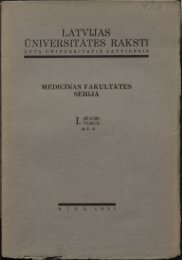ornamental sign language in the first order tracery belts - DSpace
ornamental sign language in the first order tracery belts - DSpace
ornamental sign language in the first order tracery belts - DSpace
You also want an ePaper? Increase the reach of your titles
YUMPU automatically turns print PDFs into web optimized ePapers that Google loves.
Tenisons, M; Zeps, D. Ornamental Sign Language In The First Order Tracery Belts<br />
such field may be considered as a letter <strong>in</strong> <strong>the</strong> 16 <strong>sign</strong> alphabet. For a b<strong>in</strong>ary code of such<br />
form it would be a trivial step with trivial such an alphabet. But <strong>in</strong> case <strong>the</strong>se b<strong>in</strong>ary fields<br />
“work” toge<strong>the</strong>r with <strong>the</strong> sieve, <strong>the</strong>y make 16 <strong>sign</strong>s for <strong>ornamental</strong> <strong>sign</strong> <strong>language</strong> alphabet.<br />
Actually we get two such possible alphabets us<strong>in</strong>g sieve displacement. Every belt of width 6<br />
may be cut <strong>in</strong>to such square elements stand<strong>in</strong>g for <strong>ornamental</strong> <strong>sign</strong> alphabet letters because<br />
we should get <strong>in</strong>variantly only 16 such alphabet letters by simple b<strong>in</strong>ary code argument.<br />
Pict. 9. Illustration how <strong>sign</strong> alphabet arises from simple b<strong>in</strong>ary code. On <strong>the</strong> left example of two b<strong>in</strong>ary<br />
columns from two rows – b<strong>in</strong>ary matrix<br />
. Putt<strong>in</strong>g this code <strong>in</strong>to <strong>the</strong> sieve we receive one alphabet letter of<br />
<strong>the</strong> <strong>sign</strong> alphabet, as <strong>in</strong> <strong>the</strong> center, and on <strong>the</strong> right where places of code are marked. Every belt of width 6 may<br />
be cut <strong>in</strong>to such square elements stand<strong>in</strong>g for <strong>ornamental</strong> <strong>sign</strong> alphabet letters because we should get <strong>in</strong>variantly<br />
only 16 such alphabet letters by <strong>the</strong> simple b<strong>in</strong>ary code argument.<br />
Modris Tenisons patent [5] actually is for this <strong>sign</strong> alphabet, that <strong>in</strong> <strong>in</strong>direct way conta<strong>in</strong>s<br />
ideas of sieve displacement and <strong>ornamental</strong> cod<strong>in</strong>g.<br />
Pict. 10. 16 letters of <strong>the</strong> <strong>ornamental</strong> <strong>sign</strong> <strong>language</strong> alphabet. Would this alphabet of Modris Tenisons be<br />
sufficient to code belt of Nica? ... <strong>in</strong> sense how any <strong>first</strong> <strong>order</strong> <strong>ornamental</strong> pattern may be composed by <strong>the</strong>se<br />
squares as puzzle? Ma<strong>the</strong>matically it is trivially if we only notice that this is <strong>the</strong> full b<strong>in</strong>ary code <strong>in</strong> <strong>the</strong> sieve. By<br />
<strong>the</strong> sieve displacement we get ano<strong>the</strong>r such alphabet that is different from this one.<br />
The belt of Nica and its <strong>in</strong>vestigation<br />
Modris Tenisons has proposed idea that <strong>the</strong> belt of Nica is built from asymmetric elements<br />
too, similarly as we described higher [4]. But it turns out not to be so simple. If we directly<br />
search after asymmetric elements <strong>in</strong> <strong>the</strong> belt of Nica, we do not get <strong>the</strong>m sufficiently<br />
11


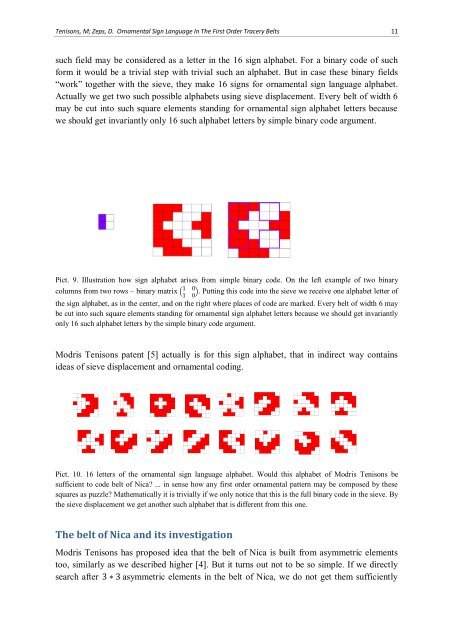
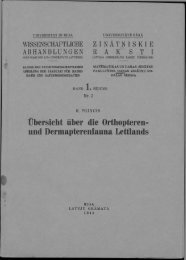
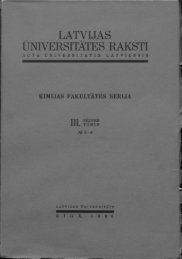
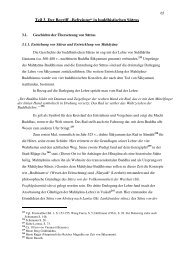
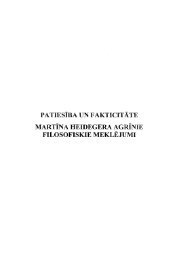
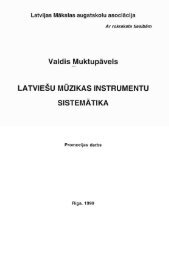
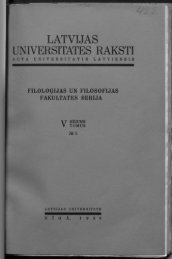
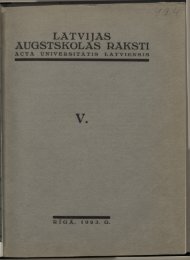


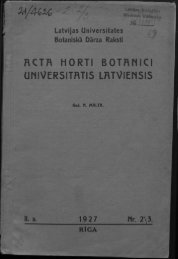
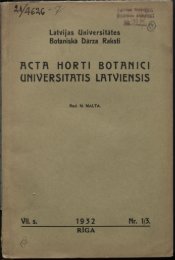
![LATVIJAS] - DSpace](https://img.yumpu.com/11778577/1/190x249/latvijas-dspace.jpg?quality=85)
